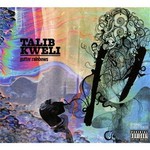Gutter Rainbows
Studio Album by Talib Kweli released in 2011Gutter Rainbows review
An album no one awaited
Talib Kweli was so much into the creative activity when he was just starting out that he failed to hold control over it and got into an accident, namely, the writer’s block. There is other way to explain what was happening to the artist throughout the years following the release of his third long player, Eardrum (2007). A rapper who is well-known for releasing new albums almost annually, promised to issue another record pretty soon and even uncovered its title, Prisoner Of Conscious. Since then, a lot of water has gone under the bridge with the audience never getting what was promised. After wandering about labels, dropping by workshops of his colleagues and participating in a number of joint projects, Kweli finally got back to his studio to process his own material. Apparently, the writing of new songs proved to be a very tiring and uninspired process, which eventually disappointed Talib. As a result, the release of the mysterious Prisoner Of Conscious, supposed to be something revolutionary and incredible, was postponed. Instead, the public was offered Gutter Rainbows, which many took as a measure to consulate the audience.
Gutter Rainbows was manufactured according to Talib’s tested and reliable methods
The situation prior the release of Gutter Rainbows is quite weird for hip-hop music. The artist, Talib Kweli, was not especially generous in supplying details about this record saying only that it features some kind of experimental stuff, a set of sings that failed to make it through to another CD. The reason why listeners still believed in the decent quality of this product was based on the fact that Talib Kweli prepared this album on his own label. This gave him unlimited writing and performing freedom he was not granted by other labels. It turned out so that Talib did not go far beyond the style he established. The songs from the Gutter Rainbows catalogue sound different only because they were done by different producers. We will again hear the familiar neo-soul beats and Kweli’s confident spitting with him still hoping for his poetic gift. The artist reveals no desire to read his verses faster or in any other way. Just like before, the thematic core of his songs is stories about the life he has known since the early childhood time (Friends & Family). Only this time, he added impressions from living in a status of a music star (Mr. International). Is it bad or good? It is rather good because you can not find flaws in the quality of execution, nor in the lyrics, or in the mid-tempo beats that help highlight all the tunes and put them straight into the listener’s head.
Demonstration of power
The Gutter Rainbows track-list consists of strong songs having no room for weak or extra pieces. The most distinguished tracks take only one listen for you to remember them. As soon as Kweli brings in something that you can not hear on the rest of the songs, you get a hit. This is exactly what happens with Cold Rain, decorated with gospel influence. The same happens with Tater Tot, enforced with heavy, striking beats and infiltrated with a dark atmosphere. There is also a portion of self-praising, but you can not go anywhere without in the rap world. Talib Kweli sang love songs to himself and gave instructions to beginners in I’m On One. The conclusion is that Talib Kweli did leave experimentations and breakthroughs for tomorrow. He seems to put very high hopes in Prisoner Of Conscious. In the meantime, А Gutter Rainbows serves as an insurance policy. It is supposed to convince Talib’s followers that he is still a good rapper and a master of word who keeps working solely with true professionals. This record has no sensation of unexpectedness or feeling of discovery. Still, it demonstrates how powerful this artist is.

